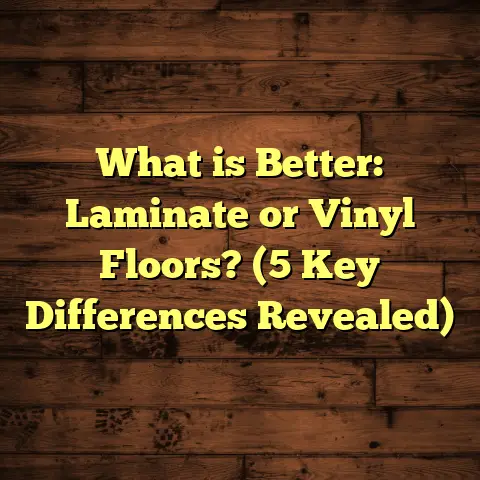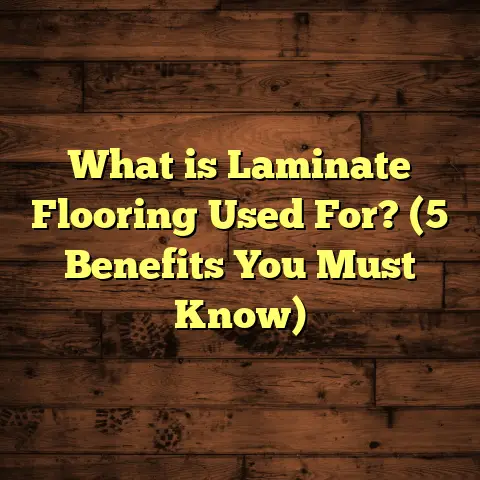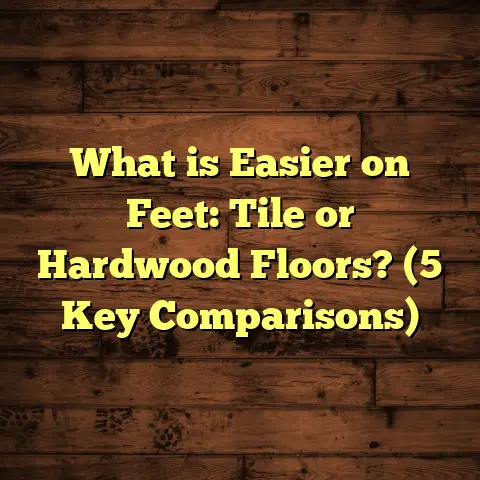What is More Durable: Porcelain Tile or Laminate Flooring? (5 Key Differences Explained)
Imagine you’re standing in a showroom, staring at two very different flooring samples: a sleek, polished porcelain tile and a warm, wood-look laminate plank. Both look great, but which one will last longer once installed in your home? If you’ve ever wondered about which flooring option holds up better over time, you’re not alone — I’ve asked myself this question many times during my years working as a flooring contractor. Over time, I’ve learned that durability isn’t just about the material’s toughness; it’s about how it fits your lifestyle, budget, and the environment where it’s installed.
What is Porcelain Tile and Laminate Flooring?
Before comparing durability, let’s get clear on what these two flooring types actually are.
Porcelain tile is a type of ceramic tile made from fine clay baked at extremely high temperatures—typically between 1200°C and 1400°C (2192°F to 2552°F). This process makes it denser, harder, and less porous than regular ceramic tile. Porcelain tiles usually measure between 12×12 inches to large formats like 24×24 inches or even larger. They can mimic natural stone, wood, or even concrete, offering versatile design options. Prices vary widely but expect to pay anywhere from $3 to $10 per square foot for quality porcelain tiles, with installation costs adding $5 to $15 per square foot depending on location and complexity.
Laminate flooring, on the other hand, is a synthetic product that mimics hardwood or stone surfaces. It consists of several layers: a protective wear layer on top, a decorative photo layer beneath it, a core board (usually high-density fiberboard), and a backing layer for stability. Laminate planks usually come in standard widths around 7–9 inches and lengths of 48 inches or so. The thickness generally ranges from 6mm to 12mm. Laminate flooring costs about $1 to $5 per square foot, with installation usually around $2 to $8 per square foot.
Both materials have their place in homes and commercial spaces, but their differences become clear when you look closer at what durability means for your specific needs.
1. Hardness and Impact Resistance
Let’s start with the basics: how well does each floor stand up to everyday wear and tear?
Porcelain’s Toughness
Porcelain tile is made from dense clay that is fired at very high temperatures. This makes it extremely hard and durable. On the Mohs scale of mineral hardness—which runs from 1 (talc) to 10 (diamond)—porcelain generally scores around 7. That means it can resist scratches from most common household items like keys, knives, or pet claws.
I recall one job in New York where the homeowners had two large dogs. They wanted a floor that wouldn’t show scratches after years of running paws. Porcelain tile was their choice. More than three years later, the floors still looked brand new despite their active pets.
Porcelain is also resistant to dents and chips under normal use. However, it can crack if hit with extremely heavy or sharp objects (think dropping a hammer). Still, minor chips are rare and often repairable.
Laminate’s Softer Surface
Laminate flooring has a surface layer made from melamine resin—a hard plastic—and a core of fiberboard. While it’s fairly tough against scratches compared to traditional hardwood floors, it’s softer overall than porcelain.
On the Mohs scale, laminate scores about 3-4. This means that while it can resist light scratches, deeper gouges or dents are possible if you drop heavy objects or drag furniture without protection.
I installed laminate flooring in several apartments in Chicago where tenants moved frequently. Within a couple of years, many planks showed visible wear marks and dents despite careful use.
Real-World Examples
- Dropping a cast iron skillet on porcelain tile usually results in a small chip at worst.
- Dropping the same skillet on laminate can create a dent or even crack the surface layer.
- Scratches from pet nails accumulate much faster on laminate than porcelain tile.
Data Snapshot:
| Property | Porcelain Tile | Laminate Flooring |
|---|---|---|
| Mohs Hardness | ~7 | ~3-4 |
| Scratch Resistance | Very High | Medium |
| Impact Resistance | High | Medium |
| Average Lifespan (years) | 25-30+ | 10-20 |
2. Water Resistance and Moisture Handling
This is one area where porcelain tile shines and laminate flooring often struggles.
Why Porcelain Excels in Moisture Resistance
Porcelain tile is fired at such high temperatures that it becomes nearly non-porous with a water absorption rate below 0.5%. This makes it highly resistant to water damage. You can install porcelain tile in kitchens, bathrooms—even outdoor patios—without worry about swelling or warping.
I worked on a coastal home in Florida where humidity levels regularly hit 80%. The homeowners chose porcelain for their entire ground floor including bathrooms and laundry areas. After five years, there were zero issues related to moisture damage.
Porcelain tiles also resist mold and mildew growth because water doesn’t penetrate the surface or grout deeply if sealed properly.
Why Laminate Needs Caution Around Water
Laminate flooring’s core is made of fiberboard—wood fibers pressed together with resin. When exposed to moisture for prolonged periods, this core absorbs water and expands. This causes swelling, warping, and sometimes bubbling.
Some newer laminates use waterproof cores or protective edges designed to resist water better than traditional laminate. But these are still less reliable than porcelain for wet areas.
In homes with basements prone to flooding or kitchens where spills happen frequently, laminate requires extra care.
Personal Experience:
A client in Texas installed laminate in their kitchen without waterproofing measures. After a few years of minor spills and humidity fluctuations, the floor started warping around the sink area. Replacing those sections cost about $500—much more than initial savings on purchase price.
Cost Implications:
Repairing water damage in laminate floors often means replacing entire planks or sections because refinishing isn’t an option.
Porcelain tile may require grout resealing ($0.50-$1 per sq ft every few years) but rarely needs replacement due to water damage.
3. Maintenance and Cleaning
How much time will you spend cleaning your floors? Let’s look at the upkeep side.
Porcelain Tile Maintenance
Porcelain tile is easy to clean with simple sweeping and mopping using mild detergents. Its non-porous surface resists stains from coffee, wine, pet urine, and oilsYour request failed. Please try again.





